1
The Creamery Exhibit - Cream separator20th Century. Circa 1930
Tatamagouche, Nova Scotia Canada
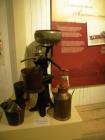 Credits:
Credits:Creamery Square Heritage Society
2
Machinery once used in the Creamery was stored - much of it outside, and some piled into the ground floor of the Shed building, although some smaller items were taken to the second floor. When it was decided that the large pieces should be disposed of, the Museum of Industry in New Glasgow was contacted in the hope they might like some of this now unique creamery equipment. They selected and took what they could.From the 1900's milk/cream separators as seen in the picture, started to become available. By the late 30's most small farms had one enabling the cream to be separated from the milk and the skimmed milk either used by the family or fed to livestock. Some cream might be kept to turn in to butter at the home, but most was sent to the Creamery being collected once or twice a week by the cream trucks, following set routes. Empty cans were returned at the same time.
The 'Nova Scotian and Weekly Herald' newspaper of April 1912, had 3 advertisements for different cream separators - the starting price was $15.95
3
Cream and milk cans20th Century. 1930 -1980
Tatamagouche, Nova Scotia Canada
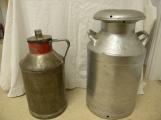 Credits:
Credits:Tinsmith Shop Museum Shubenacadie,NS
North Shore Achives
4
Cream cans changed little from when they started to be used in the early days. In the Tatamagouche area the commonly used cream cans were of tin with lead soldering made by Crocketts in Westville, Pictou County. The can to the right came from the Weston Smith factory at Shubenacadie (The Milk Can Capital of the World) . Although called milk cans, some farmers did use these for cream. They were meticulously made, with precise seams and soldering. The Shubenacadie cans have steel bottoms, and were much stronger than the earlier cans, - a necessity as they were flung from trains on to the platformsThe usual cream cans varied in size, ranging from 2 1/2 gallon ( 25 lbs), 4 gallon ( 40 lbs), 5 gallon (50 lbs), 8 gallon (80 lbs). The farmer's number was printed clearly on the sides of the two or more cans, so that at the time one was collected the second was dropped off. After 1960, when cream production was declining, farms began changing to milk production using 80lb or 100lb milk cans. Much later still tankers came into use, piping milk direct from chilled storage tanks on the farm.
For more information about the Tatamagouche Creamery see the Community Memories - ' A Community at Work - The Tatamagouche Creamery and Dairy Industry, Nova Scotia.'
5
Jars for storing cream samples20th Century 1930 - 1950
Tatamagouche, Nova Scotia Canada
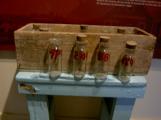 Credits:
Credits:Creamery Square Heritage Society
6
These six inch high glass bottles were used for collecting cream samples during testing. The red number is the cream can number, for easy identification. This number also refers to a specific farm with all cans of cream from that farm being marked with this number. In the early days of testing, small sample bottles were sent to the Nova Scotia Agricultural College in Truro, Nova Scotia for check tests. All samples underwent a Babcock test at the Creamery, to find out the fat content of the cream. The amount of fat determined what a farmer was paid. Later still samples went to Scotsburn and eventually inspectors came to test at the Creamery.Cream sent in from different farms was given a 'taste test'. Sweeter cream was sent away to be made into ice cream and farmers were paid extra for it. Some farmers whose cream was found not to be 'sweet' complained about the validity of the 'taste test'!
Taste testing was not a particularly pleasant job, as the sour cream was dreadful ! Often too the taster had a 'cream moustache', which he had to remember to wipe away.
7
Cream testing equipment20th Century.1950 - 1980
Tatamagouche, Nova Scotia Canada
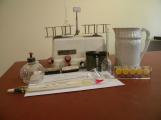 Credits:
Credits:Creamery Square Heritage Society
8
On arrival at the Creamery the cans were unloaded and cream taken from a farmer's cream can was sieved to remove unwanted materials ('things' sometimes fell into the cream from the wells in which the containers was frequently stored to keep cool!)The cream was then sent to the testing area where it underwent a Babcock test,to determine the fat content of the cream.
9
Cream pasteurizer20th Century. 1965 - 1990
Tatamagouche, Nova Scotia Canada
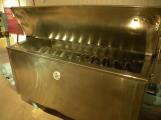 Credits:
Credits:Creamery Square Heritage Society
10
The cream from the cans was strained into a holding tank, where it was kept chilled, then pumped via an overhead feeder pipe to the four (at a later date seven) pasteurizers, lined up side by side. Steam that was heated in the early days by coal and later by oil, passed through the cylinders inside the pasteurizers, heating the cream to 170 F. It was held at this temperature for 10 to 15 minutes, and then cooled quickly to 40 F, by passing ice cold water through the cylinders. Pasteurizing was necessary to kill harmful bacteria in the cream.11
Butter churn20th Century 1965 - 1980
Tatamagouche, Nova Scotia Canada
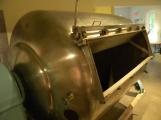 Credits:
Credits:Creamery Square Heritage Society
12
It took about 2 hours to churn a load of butter. 3 to 4 churnings a day produced some 4200 - 4800 lbs ( 1905 -2177 kilos)of butter and 5 to 6 churnings produced 6000 - 8000 lbs.(2722 - 3629 kilos) At the height of production in the 1940's, 1 million lbs.(453592 kilos) of butter were produced in a year and an average year produced about 600,000lbs.(272155 kilos) Austin Creightion, son of JJ Creightion, owner of the Creamery estimated that in its 67 years of operation, the Creamery produced 25000 tons or 50 million lbs.of butter.As the cream was churned into butter, salt was added, with more added to make 'extra salt' style butter. For every 1400 gallons of cream, 14 lbs (6 kilos) of salt and 14 lbs (6 kilos) of water were added.The churn had a capacity of 2000 gallons (9000 litres Imperial) but worked better with1400 - 1500 gallons, producing about 60,000 lbs (27216 kilos) of butter a month. The churn was thoroughly cleaned after each use to prevent possible contamination from a previous batch.
An advertisment in the newspaper- Nova Scotian and Weekly Herald , April 14, 1912 (two days after the Titanic sinking) reads
.....The Cashier said "I notice your butter cheques have been getting bigger lately - did you buy another cow?"
.....The Farmer said " No - I'm using Windsor salt - it makes better butter and I'm getting better prices - it certainly pays me to use Windsor Dairy salt"
This predates the salt that became available from the local Malagash salt mine, which started production in 1918 and continued until 1959, when it closed - and production turned to Pugwash salt - a few kilometres along the coast. Did any local farmer use 'imported' salt from out of province once local supplies were available?
13
Butter printer20th Century 1970 - 1980
Tatamagouche, Nova Scotia Canada
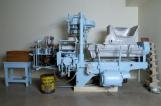 Credits:
Credits:Creamery Square Heritage Society